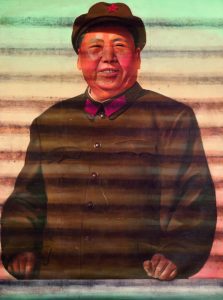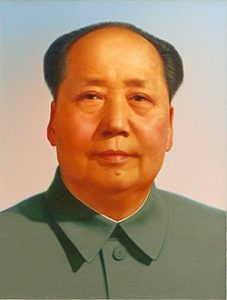

In this oil paint by Ai Weiwei titled “Mao,” the artist aims to protest the authoritarian regime of Mao through the disfigurement of his portrait. In Communist China, the portrait of Mao is considered a “sacred” image that can only be venerated by “the people.” It has been hanging on the gate of Heavenly Peace in Tiananmen Square ever since the victory of the Communist Party of China. As a prominent protest artist in China, Ai Weiwei made this portrait for the Andy Warhol Museum’s “Andy Warhol | Ai Weiwei” installation, trying to combine Pop Art and political criticism.
(in this paragraph, you may take out unrelated info and make ai weiwei’s work as well as his purpose closely connected)
This portrait of Mao, compared to the one hanging on the Gate of Heavenly Peace, is also less of an idealization and glorification of Mao’s image. In Ai’s rendition of Mao, he has a visibly wider face, with more blush, shine, and wrinkles on his face. He also has a bigger smile showing his teeth in the contemporary art portrait. In addition, the viewer can barely see Mao’s eyes because he is squinting from smiling so hard. Eyes are the windows of the mind, so by preventing the viewers from seeing Mao’s eyes, Ai is taking away part of Mao’s mind. This combination creates a slight sense of idiocy in Mao’s smile, which is in drastic contrast with the loving yet dignified gaze in the official portrait of Mao. As we discussed in class, the official portrait is an idealized image of Mao intended to glorify/magnify him and in turn the Communist leadership of China. Thus, by painting a more realistic portrait of Mao, Ai is trying to de-glorify Mao and the ideas he represents.
By placing black, semi-transparent bars over the entire portrait, Ai Weiwei criticizes the glorification of Mao by the Communist China. Those black bars are reminiscent of electric fences that often used around military compounds to strictly prohibit people from entering. In this sense, Ai is highlighting the barrier that exists around Mao’s figure. This barrier maintains the distance between Mao and the common citizens with a militant connotation, guarding both his dignity and detachment as a leader figure. On the other hand, these bars are semi-transparent, making it look like a TV program with bad reception, or a printer malfunction. By having a not-so-clear picture Mao, Ai is highlighting the distance or miscommunication between Mao and the people, that Mao’s ideology is not so clear to people today. Therefore, there exist a duality in those black bars that simultaneously criticizes the powerfulness and powerlessness of Mao, and hence the Communist government of China.
In his work titled “Mao,” Ai Weiwei expresses his criticism against Mao Zedong and the Communist Chinese government through the de-glorification and obstruction of Mao’s image (conclusion can be made here, as the rest could sound redundant) .
Although he keeps the structure of a front-facing portrait in front of a pastel background, Ai changes Mao’s expression to strip away Mao’s solemnity. The most striking part of the piece, the black bars, signify both the strength and the weakness of the message that this portrait traditionally sends.
reading comments: the claim of de-idealization and de-glorification is strong. I assume that the artist makes a connection between his work and Andy Warhol’s. in that case, mao’s portrait would serves as the subject and pop art as the form. The components of the art form, as you have identified, could include composition, color, sense of satire, costume as well as configuration. In deed, the bared frame is very important, the artist bared the leader from being idealized and glorified.
